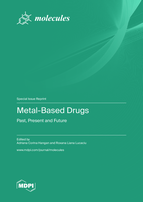Metal-Based Drugs: Past, Present and Future
A special issue of Molecules (ISSN 1420-3049). This special issue belongs to the section "Chemical Biology".
Deadline for manuscript submissions: closed (31 March 2023) | Viewed by 27455
Special Issue Editors
Interests: (bio)inorganic chemistry; biological inorganic chemistry; coordination chemistry
Special Issues, Collections and Topics in MDPI journals
Interests: anticancer research; drug discovery; metal complexes; natural products; medicinal chemistry; (clinical) biochemistry
Special Issues, Collections and Topics in MDPI journals
Special Issue Information
Dear Colleagues,
The drug discovery process is a challenging multi-step path towards the identification of potential new medicines. New drugs are needed to prevent a disease, to fight against a pathology or to diagnose a medical condition when there are currently no suitable medical products. The pharmaceutical potential of metals and their derivatives has been recognized for millennia in very different cultures, and with the advent of modern medicine, several metal-based drugs have been approved in clinical treatment as effective therapeutic tools. Indeed, a large variety of metal compounds show significant bioactivity against a range of diseases. For instance, a number of metal complexes have been developed for the treatment/cure of a variety of disorders, such as diabetes, ulcers, inflammatory and cardiovascular diseases, cancers and so on. The study of metal-based drugs represents an important part of modern bioinorganic chemistry. This Special Issue aims to provide a survey of the most recent studies concerning the computational drug discovery, design, synthesis, specific or non-specific carriers (nanoparticles, liposomes, cyclodextrins, etc.), characterization, mechanism of action, pharmacokinetic studies, etc.. of new metal drugs. In addition, studies concerning their in vivo/in vitro therapeutic properties, and therefore their possible use in the medical field, for the treatment of different diseases are of great interest.
This Special Issue will cover a selection of recent research and review articles in the field of metal-based drugs used in medicine. Studies without biological activity but whose biological activity is expected are also welcome. We encourage the submission of purely in silico studies, as well as computational studies with experimental validation. It is a pleasure for us to invite you to submit a manuscript to this Special Issue.
Prof. Dr. Adriana Corina Hangan
Prof. Dr. Roxana Liana Lucaciu
Guest Editors
Manuscript Submission Information
Manuscripts should be submitted online at www.mdpi.com by registering and logging in to this website. Once you are registered, click here to go to the submission form. Manuscripts can be submitted until the deadline. All submissions that pass pre-check are peer-reviewed. Accepted papers will be published continuously in the journal (as soon as accepted) and will be listed together on the special issue website. Research articles, review articles as well as short communications are invited. For planned papers, a title and short abstract (about 100 words) can be sent to the Editorial Office for announcement on this website.
Submitted manuscripts should not have been published previously, nor be under consideration for publication elsewhere (except conference proceedings papers). All manuscripts are thoroughly refereed through a single-blind peer-review process. A guide for authors and other relevant information for submission of manuscripts is available on the Instructions for Authors page. Molecules is an international peer-reviewed open access semimonthly journal published by MDPI.
Please visit the Instructions for Authors page before submitting a manuscript. The Article Processing Charge (APC) for publication in this open access journal is 2700 CHF (Swiss Francs). Submitted papers should be well formatted and use good English. Authors may use MDPI's English editing service prior to publication or during author revisions.
Keywords
- metal-based drugs
- synthesis
- characterization
- docking
- biological activity
- diagnosis
- therapeutic tool
Related Special Issue
- Metal-Based Drugs: Past, Present and Future II in Molecules (2 articles)








